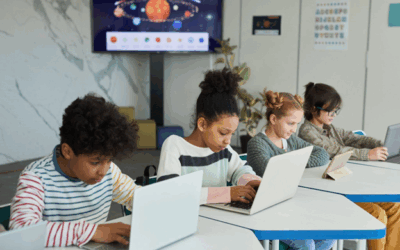With an emphasis on future-readiness sweeping the country, the conversation in education is shifting to how to prepare learners for the future of work.
The same methods, mindsets and pedagogies that were utilized when the current educational system was created (during the Industrial Revolution) are less effective for many of today’s STEM jobs, as is the teacher-in-front-of-the-classroom model. Instead, to teach in a future-ready way, educators are finding they must shift to a student-centered classroom that focuses on problem-solving and interactive and authentic learning.
A Student Engagement Model for the 21st Century
The new generation of learners has been brought up using devices early—from tablets to smartphones to virtual reality equipment and now AI. Often referred to as “digital natives,” many students are often more at home with technology than many teachers are, with the majority of students engaging with technology for multiple hours per day. And the relationship students have with technology makes a difference in how we teach.
Instead of trying to work against the allure of technology with these students, it works in educators’ favors to create engaging, interactive and dynamic environments that better match the competing stimuli in students’ lives.
However, it’s important to realize that simply putting technology in students’ hands is not enough to engage today’s digital learners in a meaningful and authentic way.
What Do Engaging Student Models Look Like?
Student engagement models differ, but research and practical experience tell us that high levels of student engagement occur when the following is present:
- Well-planned lessons connected to standards and scaffolded with memorable beginnings and endings.
- Collaborative and interactive learning that emulates the real world.
- Problem-based teaching and learning to make the experience relevant.
- Routine access to varied digital tools in environments in which students measure their own growth.
Integrating Coding into Learning Using Student Engagement Models
To help educators integrate coding and build this sort of learning environment, this article provides resources, ideas and information to answer, what is coding for students and why is coding important?
What is Coding for Students?
Coding is the process of developing and implementing various sets of instructions to enable a computer or robot to do a certain task. Coding and computer programming are an integral part of computer science education for students.
The Coder Mindset
Coding requires a growth mindset to be successful. This is true for students and teachers, who are both learners in this process. A growth mindset is the belief that intelligence and skills can be developed by putting in a sustainable and consistent effort. It creates a love of learning.
Part of coding is being meticulous and persevering. It’s looking for problems and trying to solve them. Conversely, a negative fixed mindset typically results in being unable to solve problems appropriately.
“In the fixed mindset, if you fail; you’re a failure. In the growth mindset, if you fail; you’re learning.” – Carol Dweck, Author of MINDSET
In inspiring a growth mindset in coding lessons for students, it’s important for them to understand they will likely fail many, many times and that they have to be okay with that. Failure is the ultimate opportunity to learn, so in coding, we encourage students to embrace failure.
In coding, we encourage students to fail quickly and early so they can learn from the experience and move forward. Teachers need to be the voice of persistence: “Don’t quit; there’s an answer to this.”
In this future-ready world, teachers must learn from students. To be successful with coding, teachers also must embrace a growth mindset.
Computational Thinking in Coding
Computational thinking is at the core of the coder mindset. This is a logical approach to problem solving that uses principles in computer science to solve problems.
Computational thinking does not require a computer and can be applied to ANY problem, task or system — even offline. Its five parts identify problems and formulate solutions.
What are the steps of computational thinking?
- Decomposition: Breaking something down into smaller, more manageable parts.
- Pattern Recognition: Looking for similarities and trends.
- Abstraction: Focusing on what is most important and ignoring what isn’t.
- Algorithmic Thinking: Creating step-by-step instructions to solve the problem.
- Debugging: Finding and fixing errors in the algorithm
We are all computational thinkers and computer scientists. Our brains naturally recognize patterns, create algorithms, and debug solutions.
Why is Coding Important for Students?
Try this visualization exercise: Close your eyes. We are getting ready to jump in time to the year 2035. What does this world look like? What are some of the key skills needed for this world?
Are we still going to be relying on pens and notebooks or standardized testing? Or is coding, STEM & The Maker Movement going to be dominating the future?
Most educators lean toward the second reality, visualizing a future that will lean heavily on robotics, AI, computers, technology, and innovation.
The kindergarten class that graduated at the end of the 2022-2023 school year will be graduating high school in 2035. Waiting until the year 2034 to start technology-driven learning would be a massive underservice to students. Instead, should be brought gradually into existing curriculum and scaffolded.
We live in a digital world where everyday items such as a smartphones, appliances and even light bulbs rely on code to operate. With the future heavily resting upon technology for day-to-day living, innovation, and more, it’s important that we start preparing students early for that new world.
The Current State of Computer Science
Only 57 percent of high schools currently teach introductory coding, but arguably 100 percent of the students in the country will eventually need this skill.
The latest labor statistics bring major concerns about the talent shortage. The number of unfilled tech jobs is soaring to a staggering 1.4 million. With 344K new vacancies projected to open annually, the skills gap is going to become a persistent issue over the next decade.
Every student today should have a chance to learn coding language, computational thinking, algorithmic thinking and computer science. Most students are already consumers of technology, but they don’t know the production side and inner-workings of it. Making them familiar with this is critical.
Ultimately, getting future-ready starts now.
Final Thoughts
If we believe and understand that the future will weigh heavily on technology and coding, we need to expose our students to coding today. Coding allows learners to go from users and consumers to creators and producers in the digital world.
For more information on teaching students to code, explore EasyCode computer programming platform or request a demo today.
This article was originally published in 2019 and has been updated for relevance.

Learning.com Team
Staff Writers
Founded in 1999, Learning.com provides educators with solutions to prepare their students with critical digital skills. Our web-based curriculum for grades K-12 engages students as they learn keyboarding, online safety, applied productivity tools, computational thinking, coding and more.
Further Reading
Creative & Responsible AI Classroom Activities for K–12
As AI tools make their way into students' devices, one thing is clear: educators need support in using artificial intelligence in meaningful and...
The Future of Learning: AI Lessons in Schools and Beyond
AI has already had a major impact on how students approach their learning, yet the technology is only just getting started. Wondering what else is...
Why Digital Safety Matters: Keep Your Kids Safe & Healthy Online
From schoolwork to texting friends, and gaming to streaming tv, children today are spending more time than ever on screens. In fact, an average of...




